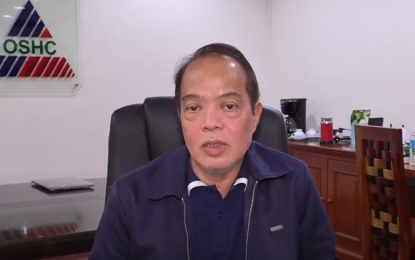
WORKING CONDITIONS. Occupational Safety and Health Center (OSHC) Executive Director Jose Maria S. Batino speaks about the work-from-home arrangements in an interview with the Philippines News Agency at his office in Quezon City on April 26, 2024. He said employees assigned to work from home should have a good working environment to keep them productive. (PNA photo)
MANILA – With the extreme heat prompting more offices to impose work-from-home (WFH) arrangements, the Occupational Safety and Health Center (OSHC) said safe and conducive working conditions at home should be considered to keep employees productive.
“I think, we need to create a balance on this (WFH scheme),” OSHC Executive Director Engr. Jose Maria S. Batino in an interview with the Philippine News Agency on April 26.
OSHC is an attached agency of the Department of Labor and Employment (DOLE) mandated to promote and advance the welfare of the Filipino workforce.
“We also need to look into the home or the housing conditions of workers that we would want to assign on a work-from-home basis. Let us look into the housing conditions. Are they better off working in their own homes whereby they do not have air conditioning? Or are they better off coming to work in the office?” Batino said.
“So, I think the challenge is there. It is so easy to develop policies that we will implement work from home. We need to look deeper into this and include in the discussion or the criteria the condition of the homes of the employees,” he added.
Batino said agencies or companies can explore innovative solutions to evaluate the performance of their employees even under remote work settings.
“In some companies that I came across, one of the things that they do is that they have an online application. So, you log in, the employee would log in in the morning, then before, after eight hours of work or even a little bit more, before this particular employee can log out, he would have to submit his or her accomplishments,” he said.
“Only after the submission of accomplishments that’s the only time that this person is able to log out, so there are ways, there are ways also of evaluating the performance of our individuals who are assigned on a work-from-home basis,” he added.
He underscored the need for employers to set parameters such as performance appraisal depending on the requirements of the companies.
“At the end of the day, it’s really how productive can the company be in a situation where a set of workers would come to work physically and a set of workers would be on work from home. So they would need to really evaluate and determine which would be a more productive scheme,” he said.
Batino also emphasized the need to always come up with mental health programs “as part of occupational safety and health” of the workers both in the government and private sectors.
“Even before the pandemic, there were already companies who are looking into stress management and other aspects of mental health because all along, they believe that mental health is very much part of occupational safety and health,” he said.
The Civil Service Commission (CSC) earlier urged more agencies to adopt flexible work arrangements (FWAs), including WFH also as a solution to traffic congestion.
The Metro Manila Development Authority has supported the CSC’s FWAs which also include working at satellite offices, or other defined fixed places.
Several lawmakers earlier also called for the return of WFH setup for both private and government employees to protect workers from the unprecedentedly high index levels.
The Philippine Atmospheric, Geophysical, and Astronomical Services Administration (PAGASA) has said high index levels will continue until the middle of May.
On Thursday, the weather bureau said 39 areas are likely to experience danger levels or 42°C to 46°C heat indices that may cause heat cramps and heat exhaustion. Continued exposure to the sun could also cause heat stroke. (PNA)
